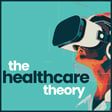
The Professor Behind the Neural Bypass | Neuvotion CEO Chad Bouton
In this episode of The Healthcare Theory, host Nikhil Reddy dives into the cutting-edge world of neurotechnology with Chad Bouton, a pioneer in brain-body interface (BBI) systems and the founder of Neuvotion.
Chad shares his groundbreaking journey from advanced robotics to healthcare innovation, detailing his pivotal work on neural bypass technology that enables paralyzed individuals to regain movement and sensation. From life-changing research published in Nature to creating non-invasive wearable solutions, Chad discusses how Neuvotion is redefining independence for patients with neurological injuries. Tune in to explore the intersection of AI, neuroplasticity, and the future of brain-computer interfaces, along with the ethical considerations shaping this transformative field. Don't miss this inspiring conversation about how innovation can restore hope and independence.



